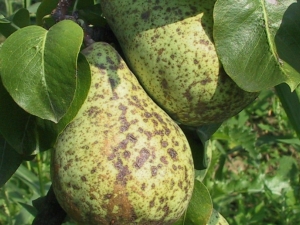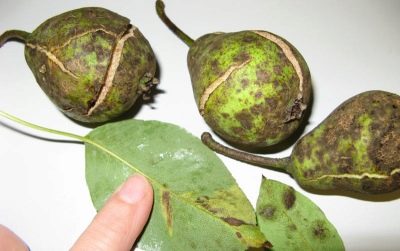Scab on a pear: why it appears and how to get rid of?

Pear has a special place as a crop grown in our country. The process of cultivation itself requires tremendous effort and a lot of time.In this regard, gardeners immensely grieved when they discovered that a tree had struck a disease. One of the most common diseases in Russia in this culture is considered to be scab. We will talk about preventive measures, causes and methods of treatment in this article.
The reasons
The scab is considered to be a fungal disease, its pathogen is the marsupial fungus Venturia pirina Aderh, popularly called venturi. This mushroom has a very negative effect on the pear, under its influence the flowers fall off, respectively, the ovary does not appear on the tree and it cannot bear fruit. The next step is the transition to the leaves, which also leads to their fall. In the case when the tree already has fruits, and only after that a scab appears on it, it is the fruits that take the brunt on themselves, which is reflected in their appearance and taste.
Increased humidity is very important for the spread of scab; it is this that creates a favorable microclimate for the reproduction of the fungus. Venturi disputes are actively developing under certain conditions, for example, in regions characterized by cold spring with rains and thunderstorms, as well as high humidity in the summer. It depends on how long the moisture stays on the tree, how fast the scab can spread. The most dangerous period is considered to be from May to July, which is when the ascospores of venturi are dispersed.
According to this, it can be concluded that the territory of Russia is quite favorable for the development and spread of this disease. The only exception is the southern regions, due to the rather hot and dry climate, their gardeners are much less likely to encounter this problem.
Externally, the scab looks like spots on the fruit and leaves, the pear is peeling off the pear. If the disease attacked the tree in the spring, the spots will be large enough if in the summer they are smaller. Sores and warts appear on various areas of the tree. In addition, if the infection process occurred during the harvest period, the disease can manifest itself on the fruits after they have been harvested. After the buds have blossomed, the scab can be determined visually after about 3 weeks.
Facilities
Every gardener, faced with this problem, breaks his head, as with the least consequences, physical and financial costs save the pear from this disease. There are several ways to solve, their effectiveness is individual in each specific case. Most people prefer chemicals. Undoubtedly, they will be able to more strongly affect the fungus, which makes it more likely to destroy it. However, we must not forget that chemicals can harm the plant, and their use is not entirely justified, if the disease only struck a pear.
Consider the most common store and folk remedies to combat this disease.
Shop preparations
The use of store preparations is appropriate only if the fungus had enough time to hit the plant. There are a lot of funds to deal with it in the stores, so it will be useful to use several at once. Treating wood with various preparations with a certain periodicity will be more effective than using only one.
Among the most famous are such compositions as "Topsin M", "Trideks" and "Merpan", they have earned popularity in the Russian market and are successfully used by gardeners throughout the country. Also, the diseased tree can be treated with mineral fertilizers, such as a solution of potassium salt or ammonium nitrate. The benefits will be double, except for getting rid of the fungus, the compounds will saturate the plant with useful substances.
However, it is necessary to take into account that any actions of such a plan should be stopped 20-25 days before the period when it is planned to harvest.
One of the most popular drugs is Bordeaux mixture.It is produced in the form of a powder and incorporates copper sulfate and lime. The mixture is diluted with water and applied to the affected area. In total, such a composition can process a tree a maximum of 4 times for the entire dacha period. In especially advanced cases, up to 7 procedures can be performed.
If the treatment is carried out before the pear has bloomed, and the tree is struck quite strongly, the solution should have a three percent concentration when the flowering is over - no more than 1 percent.
Bordeaux liquid is an analogue of the above mixture with the only difference that it already has water, but this does not mean that it does not need to be diluted. The composition is available in bottles of 100 or 500 milliliters. The cost of the liquid is slightly higher than the cost of the powder, and the efficiency is about the same. Before the procedure, you need to add water, also on the package printed detailed instructions, according to which you can calculate what concentration and for what degree of damage to the tree should be used.
"Horus" is available in the form of granules, which must be dissolved in water. It contains Ciprodinil, which helps to effectively cure the pear from scab. This will require 2 treatments - the first before the tree blooms, and the second immediately after. The interval should be 10 days, after which the agent will last for about a month.
It is necessary to fight scab when the first signs of the disease appear on the tree. In the case when the disease struck the fruits and leaves, and its traces are visible to the naked eye, experts recommend carrying out exclusively chemical treatment.
If the disease is started, it spreads quickly enough, which can lead to the loss of fruits and even the death of the plant itself.
Folk methods
It is possible to relieve a pear from such a disease as a scab, and with the help of folk remedies. However, this should be done only in the case when the tree is still not sufficiently affected. However, in easier situations, the experience of gardeners can help defeat the fungus, for example, if a tree has not completely suffered, but only partially.
Mustard powder, table salt, potassium permanganate and field horsetail are most commonly used to treat traditional methods.
It should be borne in mind that the impact of these compounds is not as fast as in the case of chemicals, however, they are absolutely not capable of harming the tree itself or the environment.
When using mustard powder, it is diluted in the amount of 80 grams in a bucket of warm water. Processing is carried out in 4 stages. The first is when buds bloom, the second is when buds are formed, the third after the flowers have fallen, and the fourth is when the fruits appear on the tree.
Horsetail is prepared in the form of infusion. One third of the bucket is rammed with a plant, filled with water and left for 3 days. As soon as the tree leaves bloom, it must be sprayed with this infusion.
In order to prepare the field solution, take 1 kilogram of salt, which is diluted in a bucket of water. This composition is processed pear. The procedure should be carried out in early spring, before the buds unfold.
The solution of sodium permanganate is prepared as follows. Potassium permanganate is diluted in proportions of 5 grams per 10 liters of water. The pear is processed when the buds are opened, after the end of the flowering phase and when fruits appear on the tree. The same solution is recommended to handle the tree trunk at the beginning of the summer season.
Treatment
To cure any disease in a tree is possible only by using comprehensive measures to combat it. Processing pears with lime and copper sulfate should be carried out several times per season, this will help stop the disease. You can also spray the plant with any other chemical agent.
We must not forget about the removal of the affected areas and the treatment of cracks. Those fruits that have already spoiled the scab, it is better to destroy.
It is necessary to fight scab systematically, until the signs of the disease disappear. If the disease is severe, it should be treated throughout the season. There should be a total of 5 procedures. The first of them is carried out in the period of bud swelling, copper sulfate will be an excellent helper, the second - in the process of bud formation using the “Skor” tool, with him after the flowering ends, and then 2 weeks later.
This scheme works well with winter pear varieties, they need to be processed at the beginning and at the end of the summer season. You also can not forget that the drugs need to be changed, then the effect of the treatment will be much stronger than when exposed to the composition, working in one direction.
Prevention
Treatment of scab on a pear is a rather laborious process, and any disease is easier to prevent than to get rid of it. Therefore, there are a number of preventive measures, which will be useful to all gardeners. After all, even if the tree is healthy and well fruited, it does not mean that it can not undergo this disease in the future.
Since scab affects not only pears, but also apples, sea buckthorn, cherries, potatoes, and a huge number of other crops, it may well spread spontaneously through infection from neighboring sites. Therefore, it is best if the tree grows in a small distance from others, in a well-ventilated area and not in the shade.
It is also necessary to take into account that cracks are a great place for the development of various types of bacteria, therefore, once a year you should inspect the tree, get rid of weak and damaged branches, and treat the affected areas with a special compound.
To prevent the fungus from falling from the branches, they should be collected as quickly as possible. Also at the end of the summer season should be made general cleaning throughout, for example, burn the fallen leaves to prevent the spread of pathogenic bacteria and fungus. However, in the case when the disease has already struck the tree, prevention will have no effect, you need to use special means.
There are varieties of pears that are resistant to this disease. They do not require treatment, tolerate moisture well and can grow in different climates. These are such species as "Annushka", "Oryol Beauty", "Belarusian Late" and others. However, in some cases, the scab can also hurt them, so that prevention is an integral part of growing this fastidious culture. Every spring the tree should be sprayed with special formulations, then by the end of the summer the pear is likely to please gardeners with tasty and healthy fruits.
How to cope with a scab on a pear, you will learn from the following video.





































